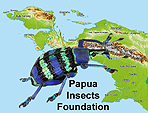

Papua-Insects.nl
The Papua Insects Foundation
Jayawijaya Mountains
The Jayawijaya Mountains are the centre part of the Western Central Mountain Range in New Guinea. It is enclosed by the Sudirman Mountains (Snow Mountains) in the west and by the Star Mountains in the east. In the north and south it is enclosed between two giant lowland areas. Some mountains have imaginable names like Mount Goliath (Peak Yamin, 4595 meter), Mount David (4581 meter). The highest peak of Jayawijaya is Mount Trikora (Peak Wilhelmina, in the former Oranje Mountains), with 4730 meter the second largest peak of New Guinea and snow covered. North from this mountain is Lake Habbema, the largest lake in this area. In the centre of the area, east from Mount Trikora, is an important area for the region: the Baliem Valley. It was rather recently discovered (23rd June 1938) by coincidence by Richard Archbold who flew with his aircraft more eastwards than usual, and this valley appeared to have a self supporting agricultural system of high standard, without having contact with the civilized world. Now many modern western technics are introduced as well as many new vegetables and crops. The Baliem Valley is a wide flat valley at an altitude of 1500 meter. There is a theory that the Baliem Valley was once a large lake, where the valley itself was the bottom of the lake. This would explain the peculiar flat area and the "entrance" (or "break through") in the South of the valley. In the valley itself is no primary forest and probably has never been there too, most of it is cultivated or are small secundary forests and bushes and plains.
Base of map by onearth.jpl.nasa.gov (modified with geographic names by Papua-Insects)
for an empty map with clear view click here
Wamena
The most important town in the Baliem Valley is Wamena which is growing fast with all consequences of a civilized city, like polution, noise and busy traffic. In 2008 there was a shortage of fuel and because of the high prices most traffic consists of bicycles, motorcycles and many betjaks (cycle taxi's), which are imported from Jakarta.
Another disadvantage of the modernization of the Baliem Valley is the decrease of traditional habits and culture. The koteka, the traditional penis covers, and the wear of the males and females, as well as the traditional housing, are disappearing fast in the Baliem Valley. Somewhat further from Wamena they can be found almost unchanged in the mountain villages of the Dani and Yali, the local tribes in the Baliem Valley. In Wamena some souvenir sellers force themselves in overdone and fake "traditional" wear, selling products and souvenirs which they never used or had originally. It is of course all part of the process of civilization, but it is a sad development.
Lake Habbema
In the West of the Baliem Valley is Lake Habbema situated at an altitude of 3224 meter. At June 29 - July 29 1938 Richard Archbold visited the lake during his third expedition in New Guinea. In that time it must have taken much effort to reach the lake but nowadays it can be reached by four wheel drive in about one day travel.
Lelambo
A four-day visit was made in 2008 by three members of our survey team to the tiny village of Lelambo (Kabupaten Yahukimo), which lies at an altitude of 900 meter at the north side of the Jayawijaya Mountains. No entomological fieldwork had been undertaken at this site before. The area is surrounded by undisturbed forest and is rich in streams and runnels. From the short visit it is clear that the area is interesting and deserves more fieldwork. During three evenings insects were collected at light and during daytime dragonflies were collected.
Walmak
For the second time we paid a visit to Walmak, a small mountain village in District Nipsan (Kabupaten Yahukimo). We have been there before in 2005 and the reason for our return in 2008 was that particular this locality was a very successful one concerning collecting at light. And again Walmak proved to guarantee a very successful collecting site. We now went in another period of the year which resulted in many different species compared to 2005 and, as we yet can overview, also with many new species for science.
Scenes at Walmak, Jayawijaya Mountains (2008)
During day trips and collecting at light our photographer Joop Schaffers made many pictures of moths and other insects which will be presented in the website when appropriate. Collected material is stored at the ZMAN.
Entomological expeditions